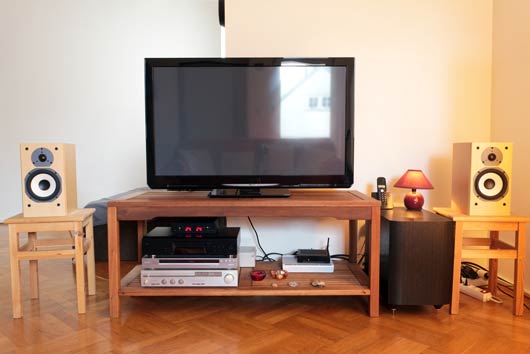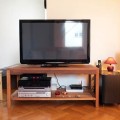
UPDATED November 15th, 2017
If you’re a movie aficionado with a massive archive of converted DVDs stored on a terabyte-sized hard drive, having a personal home theater is a real treat. But it’s an expensive one. Home theaters can easily cost tens of thousands of dollars; however, by building your own, it’s entirely possible to get a great viewing experience at home without breaking the bank. Here are a few budget-conscious tips to keep in mind if you want to upgrade from a bland TV+sofa combo:
Listen Closely: Keeping Acoustics in Mind
Whether you’re converting an unused room or the basement, there are two things that will always make or break having an awesome home theater: image and sound quality. Ensuring image superiority is fairly simple, but getting a rich, accurate sound isn’t as straightforward and requires a lot more consideration than just buying a fancy sound system. When remodeling a room into a theater, it’s critical to remember that to eliminate penetration by outside noises, the room needs to be built to absorb sound instead of reflect it.
Read Related: 6 Signs You Need a 12-Step Program for DIY
There are three major areas to look at when considering a room’s acoustics: the ceiling, walls and floor.
The ceiling can the most complex and time consuming aspect of remodeling your new media room, depending on how far you want to take the renovation. Acoustic fiberglass tiles are the ideal ceiling material, but if tearing out and rebuilding the ceiling isn’t an option, then adding two layers of standard fiberglass insulation will do a good enough job. While adding the insulation, setting up the wiring for a sound system, lights and projector should also be done.
Walls constructed out of drywall and plaster have terrible acoustic properties. The walls send sound reverberating all over the place. Destroying and rebuilding a room, wall by wall, isn’t an option for most people. The solution is to buy basic wood panels and then insulate them with a thin layer of carpet, which is close to the acoustic paneling that most movie theaters use.
Finally, the floor will be the last acoustic issue concerning the room itself. Tile, concrete, linoleum and wood will reflect sound like crazy and completely distort the audio, but carpet is fairly absorbent. Look at getting a plush carpet, which will feel nice underfoot and keep the sounds from bouncing around.
Getting in the Mood: Setting the Perfect Ambience
So the room is going to carry audio like an opera singer. Now it’s time to make it look stunning too.
The lighting is the most important ambience aspect, and that includes the room color. “Your primary concern with painting the room is to use a flat, neutral color. This will limit the amount of light reflected by the walls and ceiling, and dark colors will help the room fade away and allow you to see nothing but the screen,” according to How Things Work.
Besides the paint colors, installing a new light source will be important. Using rope LED lights to outline the floor is one option, as is installing controllable dimming lights on the walls.
The next item for consideration is the seating arrangement. If you’re on a tight budget, simply using some nice recliners will work. But if a more authentic passion is fueling your project, there are hundreds of comfortable seating options ranging in price. Remember if you’re creating front to back rows like a standard theater, make sure the seats in the back are elevated higher than those in the front so everyone has an equal view.
The Fun Toys: What Electronics to Buy
Now that the room is acoustically ready and looks dashing, and it’s all wired for speakers and a projector, the time has come to go shopping for the meat of your home theater. The two main things to not be too cheap on are the sound system, and the video projector.
Lugging a massive physical TV into your new theater might work for some people, but installing a screen and projector is a much better option. A quality projector isn’t necessarily cheap, ranging from $300 all the way up to $5,000, and a drop down screen will also cost about $200. But the size is customizable and it looks fantastic. The only major drawbacks about using a projector and drop screen are the projector can take time to warm up and cool down, the expensive bulbs need replacing every few thousand hours of use, and having complete control over the room’s lighting is crucial to maintain video quality.
Finally, the sound system is your next item. Splurge for a 7.1 surround sound system if the room is a decent size and a 5.1 system if it’s fairly small. You don’t want the sound to be too powerful. A good surround system should have speakers equally spread out and installed in the ceiling, with the subwoofer in the back and smaller speakers being near the corners. A respectable surround sound system is going to run anywhere from $200 to $500.
The best way to proceed when considering your DIY home theater is to decide on a budget, then determine what is possible within that budget. In the end, you’ll have a home theater that is the talk of the town—or at least of your neighborhood block!












